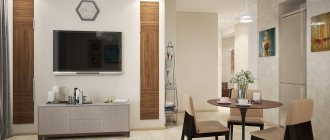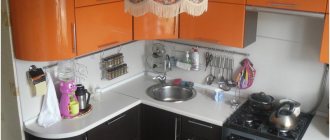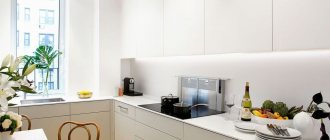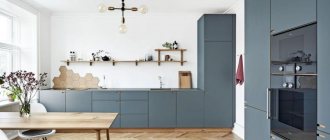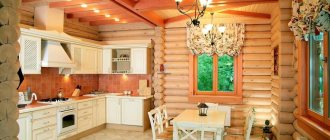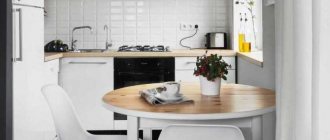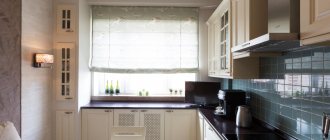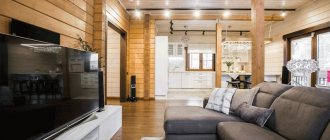If you think that brick can only be used for exterior decoration, you are mistaken. Designers often use this material when decorating various types of premises. However, most often brick walls are decorated in the kitchen - a reliable, durable and beautiful material has excellent performance properties and adds coziness to the room.
The use of brick makes any kitchen original and cozy
Read our article about how to properly decorate a kitchen using brick, what its features are and how best to use brick elements in the interior.
Advantages and disadvantages of brick in the kitchen
Like any finishing material, brick has both its pros and cons. Moreover, both of them can be considered quite significant.
A brick wall is a beautiful, but rather difficult move
It should be noted that brickwork in general is a rather unique material - on the one hand, it looks very stylish, on the other hand, it must be used carefully in the interior so as not to get the effect of an unrenovated room.
So, let's look at the list of advantages of brick in the interior:
- First of all, these are its operational properties. Brick is a reliable and durable material that can withstand difficult conditions in the kitchen. Constant moisture, temperature changes, greasy drops - all this will not cause significant damage to your wall. Therefore, brick is often used, among other things, for finishing the apron.
- The brick wall looks very unusual and attracts attention. This finish looks stylish and beautiful, if, of course, you managed to correctly use it in the interior.
- This is one of the most economical ways to decorate a wall. You will not need additional finishing, and the brick itself is not too expensive.
- The material has excellent heat and sound insulation properties, so there is no need to lay a separate insulating layer.
- In fact, brick is a universal material . It is used not only for wall decoration, but also for floors, ceilings, decorating a kitchen island or bar counter, and an apron. All this allows you to create an original and holistic interior.
- If you wish, you can do without the help of builders - laying brickwork in one row is not difficult with your own hands , even if you have never done repairs before.
- Brickwork is a great way to zoning space . By decorating a wall or part of it in this way, you can separate the kitchen area from the dining room and allocate a specific place in the kitchen.
- Brick goes well with all other materials. Wallpaper, tiles, decorative plaster - you are practically unlimited in finishing combinations.
As you can see, brick is an inexpensive material that can be widely used in the interior of the kitchen. In addition, it has excellent performance properties.
What about the downsides? Let's see what you need to be careful about when working with brick:
- If after the list of advantages you have a desire to decorate all the walls with brickwork, you will have to abandon it. Brick should be used sparingly in the interior, even if you are a fan of the urban loft. Otherwise, instead of a beautiful and cozy kitchen, you risk getting a strange room that evokes associations with an abandoned construction site.
- Despite its strength, brick requires very careful maintenance. It has a porous, heterogeneous structure. Due to this, grease and dirt accumulate in the seams. This means that you will have to wipe such a wall regularly - otherwise you risk quickly ruining the appearance of the wall.
- If you choose red brick to decorate the room, you won’t be able to save on lighting - you will need a lot of artificial light . Terracotta brick practically does not reflect light fluxes, so you will need many times more lamps than when using other materials.
- As already mentioned, you should handle bricks with care. Especially if you decide to choose dark tones of the finishing material, go a little overboard, and the room will seem gloomy and unkempt.
As you can see, the disadvantages can be considered quite conditional - if you show common sense, correctly design the lighting system and do not forget about caring for the brickwork, such a wall will serve you for a long time without losing its appearance and performance properties.
If there is a lot of brick in the interior, you need to work with it very carefully
With the right approach, brick helps create a very beautiful interior.
Combine brick with less capricious interiors so as not to overload the space
How to properly use brick in the interior? We hope the advice of our designers will help you with this!
Necessary tool
Bricklaying tools.
When building a kitchen with your own hands, you will need the following tools:
- perforator;
- Bulgarian;
- Grinder;
- hacksaw;
- hacksaw for metal;
- putty knife;
- Master OK;
- paint brush;
- trowel;
- mallet;
- hammer;
- level;
- plumb line;
- ruler.
Tip 1. Study the rough finishing of the kitchen
Perhaps you are lucky and live in a house with brick walls. In this case, we recommend that you do not invent unnecessary problems for yourself - it is quite possible that you will not need to additionally lay decorative bricks.
Sometimes it is enough to remove the finishing trim to get a beautiful brick wall
It will probably be enough just to carefully clean the wall - sand the seams, remove all dirt.
This way you will get a great brick wall without breaking the bank. However, this is not always possible. If you are unlucky with a brick wall, the next point is for you.
The main thing is to balance the interior well
This kitchen looks very original
Scandinavian
This style often uses white and gray tones, or combinations thereof.
Compared to the loft style, here the brick looks more natural. At the same time, the design looks simple and tasteful. A wall in this design will be highlighted and bright.
Tip 2. Decide on materials
At first glance, this advice sounds strange - a brick is a brick. What is to be determined here? However, in fact, the issue is deeper than it might seem at first glance.
A wide variety of materials can be used as bricks in the kitchen.
Most often, special decorative bricks or its imitation are used for the kitchen. Variations are possible here. We recommend that you familiarize yourself with the list of materials to make the right choice.
First of all, we do not recommend using wallpaper with a brick print. Yes, such a coating can be distinguished by high quality printing and at first glance be very reliable. However, the absence of a characteristic structure will completely kill the special charm that is inherent in brick walls.
One of the most popular options is ceramic tiles that imitate brick. Firstly, it is very easy to install. Secondly, the appearance, thanks to the volumetric texture, fully matches the brickwork. In addition, due to the special glaze, such tiles are ideal for finishing an apron - cleaning such a coating is much easier than natural porous brick.
Sand-lime bricks are also good for kitchens. The properties of the material provide them with increased resistance to moisture, steam and temperature changes. Plus, they look very beautiful and authentic. They are produced in various colors. In addition, the coating can be painted - a great way to quickly update your kitchen interior.
Very often, gypsum tiles are used to decorate kitchens. They can be of different shapes and sizes, so using them is easy to recreate any type of brickwork.
Gypsum can be used in different areas of the kitchen
A nice bonus is the thickness of the gypsum blocks. It is only five millimeters, so gypsum is ideal for small kitchens. The color scheme is also pleasing - from the usual white and terracotta to complex, sometimes unexpected colors.
An interesting solution is the use of MDF panels that imitate brickwork. This is perhaps the fastest way to decorate your kitchen like a brick. Due to the fact that the panels are quite large in size, you can lay the entire wall in a matter of hours. In addition, it is almost impossible to visually distinguish a fake from real brickwork. However, remember that in terms of performance properties, brick significantly exceeds the characteristics of MDF panels.
Even this one. the panel can be installed in a matter of hours
Masonry options
The apron with bricks in the kitchen is laid in two ways - with and without seams. With the first method, it is necessary to maintain a gap of a certain size. After registration, the remaining space must be thoroughly wiped down. The whole process takes quite a long time.
The main difficulty is aftercare. A brick-look kitchen apron with seams absorbs grease and moisture, and dirt and dust quickly stick to it. Grouting is repeated periodically.
Installation of the second type is carried out much faster - solid slabs are installed without grouting. Often additional skills and tools are not required; subsequent care and changing the interior will not cause much trouble.
The herringbone installation option looks interesting, the apron becomes the central element of the interior
In addition, you can choose the arrangement of the bricks: herringbone, classic, vertical. The first and last are considered quite original, so they can diversify even a calm interior.
Tip 3. Decide on the texture
The brick does not have to be porous, like the one we are used to seeing in exterior decoration. Now the blocks are treated with a special glaze, which allows you to give the most varied appearance to the material.
Bricks can be very different
For example, you can use classic matte bricks - they are great for creating traditional interiors.
The usual matte brick
However, glossy glazed bricks also look very interesting. In addition, due to their reflective properties, they visually make a small kitchen larger. A significant bonus, especially when you consider that the brick itself conceals the space, making it smaller and cramped.
Interesting and attractive solution
A fashionable solution for interiors in the industrial loft style is chipped brick. The blocks appear a little broken, their edges are torn, and their texture is uneven. Due to this, the coating seems very voluminous and original. True, you need to work with such material very carefully, otherwise the kitchen will take on a sloppy, abandoned appearance.
Rough finishes should be compensated with elegant furniture
Construction of the foundation
A summer kitchen is a massive structure and therefore must have a reliable foundation, the appropriate type of which is determined based on the size of the structure and the expected load.
You can learn how to choose a foundation for construction and what features of each type of masonry can be found in the article “Foundation for a gazebo.”
Photo: monolithic foundation design. Read the article: “Foundation for a gazebo.”
Often, for brick structures, a monolithic or strip foundation is poured with a depth of up to 80 cm. The solution hardens within 1–2 weeks, depending on weather conditions.
When the base is ready, you can begin arranging the floor. It is laid with tiles or stones on top of the cement screed.
It is worth considering that the floor level in an open kitchen is at least five or even ten centimeters above the ground. This will prevent rainwater from entering and accumulating on the floor of the room.
Tip 4. Find the right color scheme
There is an opinion that brick walls can only be red, terracotta or white. This is fundamentally wrong. Modern possibilities make it possible to give brickwork any color - and we’re not even talking about painting, which gives you the chance to change the interior of the kitchen at least every month.
You can find brick in almost any color
In addition to classic solutions, you can choose almost any color. Brickwork in unexpected tones looks very interesting - blue, pistachio, green, straw.
We recommend choosing textured shades - interspersed with minerals and various decorative additives. This will make your wall seem more original and voluminous.
Bricks painted using the ombre technique look interesting
In addition, you can experiment with color combinations and even lay out a unique brick mosaic. However, keep in mind that such a solution requires quite a lot of financial costs and effort - nevertheless, decorating an ordinary brick wall is much easier. But the result will be much more original.
Take the time to find an interesting type of brick
Roof installation
There are no restrictions in choosing the type of roof. But the easiest to build is considered to be single or double slope. An important installation condition is maintaining the correct angle of inclination.
Suitable materials:
- corrugated metal sheets;
- tiles;
- slate;
- metal tiles;
- ondulin.
To make the roof frame, longitudinal and transverse beams and bars are used, and sheathing is made. If this is a closed building, then before laying the roofing material it is necessary to make a layer of thermal insulation made of mineral wool.
An important stage of roof installation is the installation and removal of the chimney. All work must be carried out in accordance with the set of rules SP 7.13130.2013.
Photo: chimney lining diagram
Therefore, you need to consider the following:
- The optimal pipe height is 5 m and above. With a lower value, problems with traction may occur.
- It is better to install the chimney at the ridge of the roof. If placed lower, there will be a high probability of snow bags in winter.
- The minimum distance of a brick chimney to combustible materials is 13 cm.
- Hydro- and thermal insulation of the pipe is required. In the first case, with a special film, in the second - with basalt mineral wool.
The roofing material must be positioned so that its edges extend beyond the frame. When draining, the water will not enter the room.
After installing the roof, you can begin installing windows and doors.
Tip 5. Take care of additional processing
If you want to place a brick directly next to the oven or use it to decorate an apron, we recommend that you additionally cover it with a thin layer of scraping varnish. This will greatly simplify cleaning - dirt and grease will not penetrate the pores of the material, which means the coating will last you longer.
If you want to use brick near the work surface, it is better to further process it
If you are afraid that such processing will spoil the texture of the brick, do not worry. Modern materials can be applied in one layer, so that they form a thin protective film, not too noticeable at first glance.
Modern means make processing invisible
In addition, no one forces you to choose a flashy glossy finish - you can easily use matte varnish.
How to build a stove complex inside a summer kitchen
If you plan to build a barbecue stove or other type of wood-burning stove inside, you should provide a convenient place for it in advance so that you can make a separate foundation.
The following article will help you choose the appropriate type of stove and learn about the main stages of its construction: “Stoves for gazebos.”
It is not recommended to work with concrete mortar at temperatures lower than +50 C. Its uneven drying will lead to the appearance of cracks on the surface.
The stove masonry is made with fireclay (fire-resistant) bricks two weeks after pouring the base.
Read the article: “construction of a furnace complex.”
If the owners want the stove to be built professionally, then its construction can be ordered from craftsmen who will create a reliable turnkey stove and do it quickly.
No less convenient are ready-made factory versions of furnace complexes, which can be purchased in stores at an affordable price.
Tip 6. Try painting the brick to match the walls
Do you have a small kitchen that you want to make more comfortable? A single-color covering for all walls and brick in the dining room or work area is a very suitable solution. To make the room even prettier, we recommend sticking to one color scheme.
Nice monochromatic solution
This way the brickwork will stand out only due to its volumetric texture. This move will add coziness to the room, but the brick will not attract attention - for a small kitchen it is better not to use too flashy techniques.
This combination looks very impressive
Brick finish on the entire wall
The kitchen design, made by finishing one or more walls with brickwork, will look original due to the correctly selected household equipment.
A brick wall can be the basis for subsequent decoration of the kitchen space. The surface, made of old-style red brick, always looks elegant and is suitable for creating a modern style.
Tip 7. Organize your lighting correctly
Brick does not have very good reflective properties. Therefore, we recommend placing a brick wall opposite the window - so natural light will smooth out this effect.
A kitchen with brick requires a lot of light
In addition, it is very important to properly highlight a prominent wall. Use several lamps at once - this will help highlight the beauty of the brick.
Lamps must fit into the interior and complement it
Additional lighting won't hurt
Pop Art
A brick-colored kitchen design created in this style looks creative and original. The interior of a room may contain several shades at once.
The presence of brightly colored accessories in the room against a brick background looks bright and catchy.
Tip 8. Caring for untreated brick is an important task.
If you decide not to glaze or paint your brickwork, you will have to take very good care of it in your kitchen. This is especially true for bricks laid in the area of the slab or apron.
This apron looks beautiful, but requires special care
Any greasy stain is dangerous - it can be absorbed into the porous structure and noticeably change the color of the material.
Therefore, it would be the best solution to keep some kind of grease solvent in the kitchen - as soon as the stain gets on the surface, carefully remove it.
It is also important to promptly remove water that gets on the brick. It tolerates air humidity and steam well, but prolonged contact with liquid may cause whitish stains on the material.
Untreated bricks need to be wiped down regularly
Provence or country
Brick is often used to create a romantic Provence or country style. Moreover, it is important to observe an important condition - the finished design should look natural or be artificially aged.
It is advisable to use light shades, such as white, milky, light olive and others. One has only to look at the photo of a brick kitchen, how such a range emphasizes a unique feature - the bright illumination of the room with light.
Tip 9. Decide on a style
Why did we put it at the very end of the article? We have already mentioned that with the right approach, brickwork can fit into almost any interior.
Classic set with brick wall
However, there are still styles where the use of brick is much more preferable than others.
First of all, this is, of course, a loft. Along with concrete, brickwork is recommended for use in such interiors.
A great example of an urban loft
Brickwork in such styles as country and Provence has proven itself well. Here it is better to choose not too large blocks and light shades.
Cozy country kitchen
White brick is practically a must-have for the Scandinavian style. This wall fits perfectly into the concept and makes the interior light and spacious.
A Scandinavian kitchen cannot be imagined without white brick.
For other types of interiors, brick can be used, but this should be done with caution. Choose colors that suit the design concept of the style, make sure that this material does not conflict with others. It is difficult to imagine a textured “broken” brick wall in the Victorian style. But elegant bronze masonry is quite appropriate there.
American style kitchen with brick wall
Use common sense and stylistic rules - and everything will work out.
How to choose by headset
Designers advise starting to choose the color and material of the kitchen apron only after selecting the main furniture, namely the set.
It is important to select compatible elements - take into account shades, style, matching materials
There are several basic techniques for combining shades in any space:
- partial - the apron in the area of the hob is designed in the same style as the facade, the rest is done in neutral colors;
- the opposite means the use of contrasting elements and details (glossy and matte surfaces, black and white, gray and red);
- combination with the color of the furniture - in this option, the shade of the work area echoes the table, sofa, chairs and other key details;
- one color with flooring, walls or furniture.
In a two-color kitchen, the apron is usually made in one version, and the wall and floor cabinets in another. The basic rule is to choose a lighter shade for the work area.
Making the apron, countertop and flooring in one color looks seamless if the depth of the shades is combined with each other. An interesting element will be the uniformity of the workspace and the table.
An apron in a small kitchen is of great importance - a small space requires compliance with certain rules. You can visually “push apart” the walls using light shades and gloss. The Total White style is gaining popularity - a completely white space, including furniture, floors, ceilings and the rest. Bright contrasting accents – pillows, jars, indoor flowers – will help diversify the interior.
Brick in the kitchen interior: 30 real photo examples
To clearly show how advantageous a material brick can be, we have compiled a selection of photographs. Brickwork in kitchens in various styles - we are sure you will like it!
Loft
To carry out a design in a similar direction, it is impossible to imagine a material of a different type. Rough design in combination with decor creates a “natural” atmosphere.
Advantages of decorating with bricks
Decorating brick kitchens with your own hands has a number of advantages. These include:
- a good opportunity to divide the space of the room into zones;
- is an unobtrusive element of decorative design;
- it is an inexpensive material that does not require additional finishing;
- This design is distinguished by its durability.
This is not a difficult type of work that does not require special knowledge and skills.
